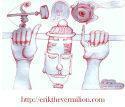Be Kind! Share with your Team, with your Family, with your Buddies!
Click The Button Now & Like This On Your Facebook Page!
Monday, January 20, 2014
Information On How Do Glowsticks Work?
The real light stick is merely a form of housing the 2 solutions. In the stick, the 2 solutions are kept in separate chambers. The phenyl oxalate ester and dye solution fills most of the glow stick, while the hydrogen peroxide solution is held in a smaller sized glass vial within the middle of the stick. This is why glow sticks should be bent to trigger - bending the plastic stick breaks the glass vial open, enabling the 2 solutions to blend.
The glow stick can stay lit for hours, if enough substances are utilized. Nonetheless, even more commercial glow sticks are likely to last as much as 30 minutes. Likewise, heating up the glow stick will trigger it to glow better, however it will likewise dim faster. Similarly, cooling the stick will decrease the process and trigger a dimmer light to last much longer. Freezing a glow stick can trigger the light to last for several days, though it will eventually fade out.
Although some sites offer info on ways to make a glow stick, this is dissuaded unless a person has a background in science and significant training in chemical substances. While fairly safe, mixing the substances incorrectly can cause inadvertent results, and the dye can hurt clothes and other fabrics.















